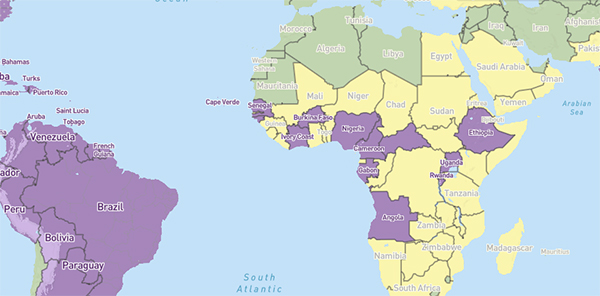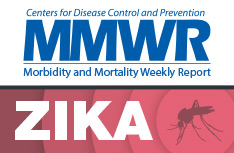Geographic areas at increased risk for Zika virus transmission through donation of human cells, tissues, or cellular or tissue-based products (HCT/Ps)
Zika virus information for HCT/P establishments
CDC is working with US Food and Drug Administration (FDA); state, territorial, and local health departments; and HCT/P establishments to help ensure the safety of the HCT/P supply and reduce the risk of Zika virus transmission through implantation, transplantation, infusion, or transfer of HCT/Ps to a human recipient. HCT/Ps such as amnion/chorion hematopoietic stem/progenitor cells from cord blood and peripheral blood, and reproductive tissues such as semen and oocytes, have the potential for harboring Zika virus. Zika virus disease is a nationally notifiable condition. Domestic cases are reported to CDC by state, territorial, and local health departments using standard case definitions.
FDA Resources:
- Important Information for Human Cell, Tissue, and Cellular and Tissue-Based Product (HCT/P) Establishments Regarding Zika Virus Transmission Risk in the World, February 28, 2019
- FDA – Donor Screening Recommendations to Reduce the Risk of Transmission of Zika Virus by Human Cells, Tissues, and Cellular and Tissue-Based Products (Updated May 2018) [PDF – 12 pages]
Areas at increased risk for Zika virus transmission through HCT/P donation in U.S. states
To protect the HCT/P supply, CDC, in collaboration with FDA, has a process to define areas at increased risk for Zika virus transmission through HCT/P donation. For the purposes of HCT/P safety interventions, areas at increased risk for Zika virus transmission will be identified at the county level in U.S. states. Defined areas of risk can be different from areas for which CDC has issued travel guidance.
Updated as of October 11, 2022:
There are currently no areas at increased risk of Zika virus transmission through HCT/P donation in the U.S. states.
Previously listed areas at increased risk for Zika virus transmission through HCT/P donation in U.S. states for the purposes of HCT/P safety intervention:
- Hidalgo County, Texas – From September 1, 2017 – February 7, 2018
- Cameron County, Texas – From December 9, 2016 – August 29, 2017
- Miami-Dade County, Florida – From July 29, 2016 – June 2, 2017
- Palm Beach County, Florida – From August 24, 2016 – November 2, 2016
Areas with risk of Zika outside of U.S. states
Residence in or travel to an area with increased risk of Zika virus transmission, and sex with a person known to reside in or travel to an area with increased risk of Zika virus transmission, are considered Zika virus risk factors for the purpose of determining eligibility of living donors of HCT/Ps. Based on laboratory analyses and mathematical modeling, a conservative yet plausible estimate for introduction of Zika virus and substantive risk of exposure in North America, South America, Central America, and the Caribbean is January 1, 2014 (1,2,3). Furthermore, scientific evidence confirms Zika virus presence in some African and Asian countries for decades, in some cases dating back to the 1950s (4,5,6).
Please refer to the world map at this link for areas with risk of Zika outside of the United States: The map categorizes countries in 4 shaded categories:
- Country or territory with current Zika outbreak (Red)
- Country or territory with any prior or current reports of mosquito-borne Zika transmission (Purple)
- Country or territory with the vector and no reported mosquito-borne Zika transmission (Yellow)
- Country or territory with no mosquitoes that spread Zika (Green)
FDA considers countries and territories outside the U.S. states categorized as “Red” or “Purple” as areas with increased risk of Zika virus transmission.
For the purposes of blood and tissue safety intervention, the following list indicates the date an area’s shade first became purple (or red) after the map updates were introduced on February 28, 2019:
France: October 21, 2019
Kiribati: February 6, 2020
Guinea: October 4, 2023
Sri Lanka: October 4, 2023
References
- Benjamin I, Fernandez G, Figueira JV, et al. Zika virus detected in amniotic fluid and umbilical cord blood in an in vitro fertilization-conceived pregnancy in Venezuela. Fertil Steril 2017;107(6):1319-1322.
- Bhatnagar J, Rabeneck DM, Martines RB, et al. Zika Virus RNA Replication and Persistence in Brain and Placental Tissue. Emerg Infect Dis 2017;23(3):405-414.
- Centers for Disease Control and Prevention. Evaluation of Placental and Fetal Tissue Specimens for Zika Virus Infection – 50 States and District of Columbia, January-December 2016. Morb Mortal Wkly Rep MMWR 2017;66(24):636-643.
- Centers for Disease Control and Prevention. Update: Noncongenital Zika Virus Disease Cases – 50 U.S. States and the District of Columbia, 2016. Morb Mortal Wkly Rep MMWR 2018;67(9):265-269.
- El Costa, H, Gouilly J, Mansuy J-M, et al. ZIKA virus reveals broad tissue and cell tropism during the first trimester of pregnancy. Sci Rep 2016;6:35296.
- GarcÍa-Bujalance S, Gutiérrez-Arroyo A, De la Calle F, et al. Persistence and infectivity of Zika virus in semen after returning from endemic areas: Report of 5 cases. J Clin Virol 2017;96:110-115.
- Mead PS, Hills SL, Brooks JT. Zika virus as a sexually transmitted pathogen. Curr Opin Infect Dis 2018;31:39-44.
- Nicastri E, Castilletti C, Liuzzi G, et al. Persistent detection of Zika virus RNA in semen for six months after symptom onset in a traveller returning from Haiti to Italy, February 2016. Euro Surveill 2016;21(32):30314.
- Paz-Bailey G, Rosenberg ES, Sharp TM. Persistence of Zika Virus in Body Fluids – Final Report. N Engl J Med, 2019;380:198-199.
- Sanchez-Montalva A, Pou D, Sulleiro E, et al. Zika virus dynamics in body fluids and risk of sexual transmission in a non-endemic area. Trop Med Int Health 2018;23(1):92-100.



